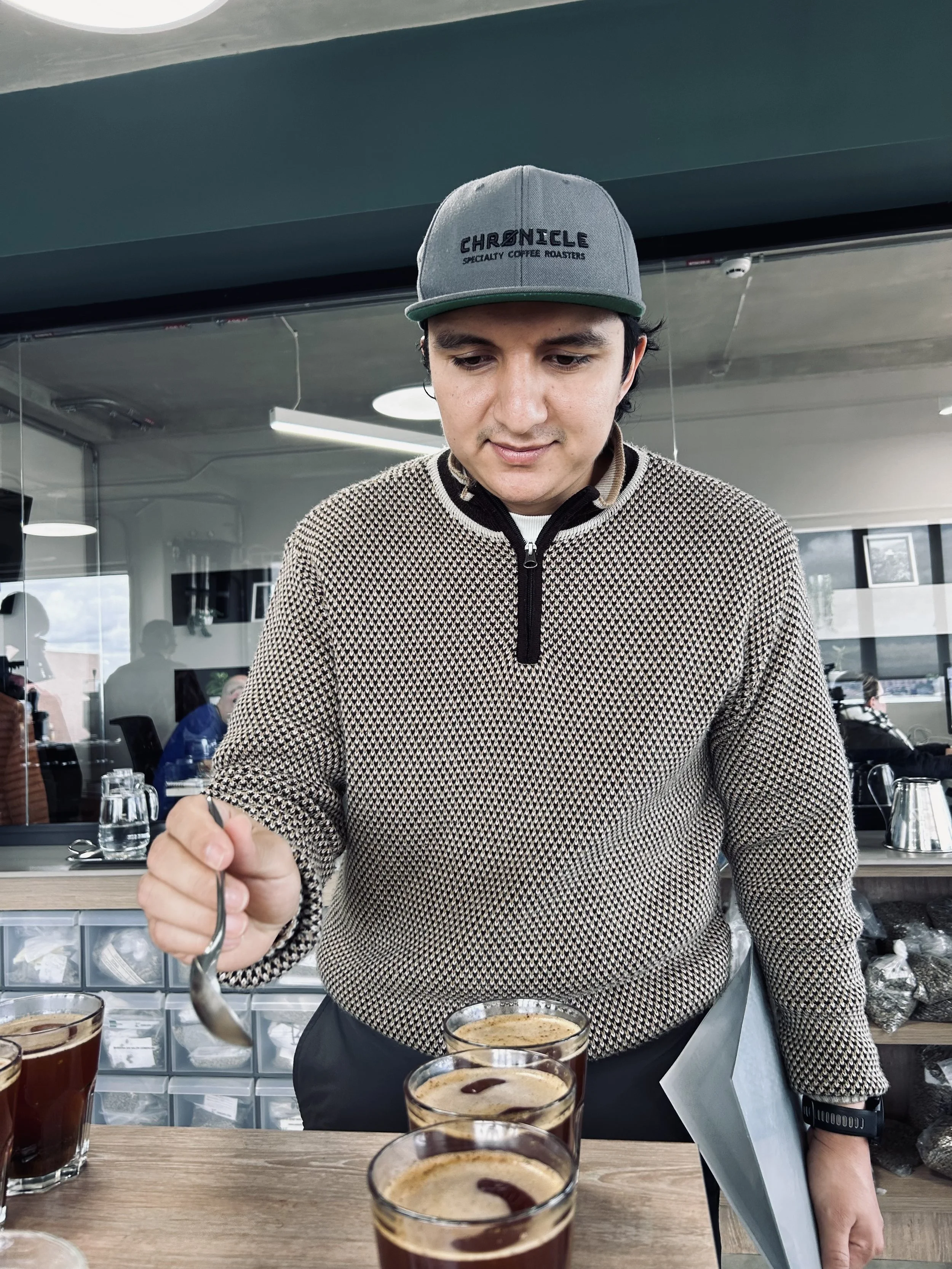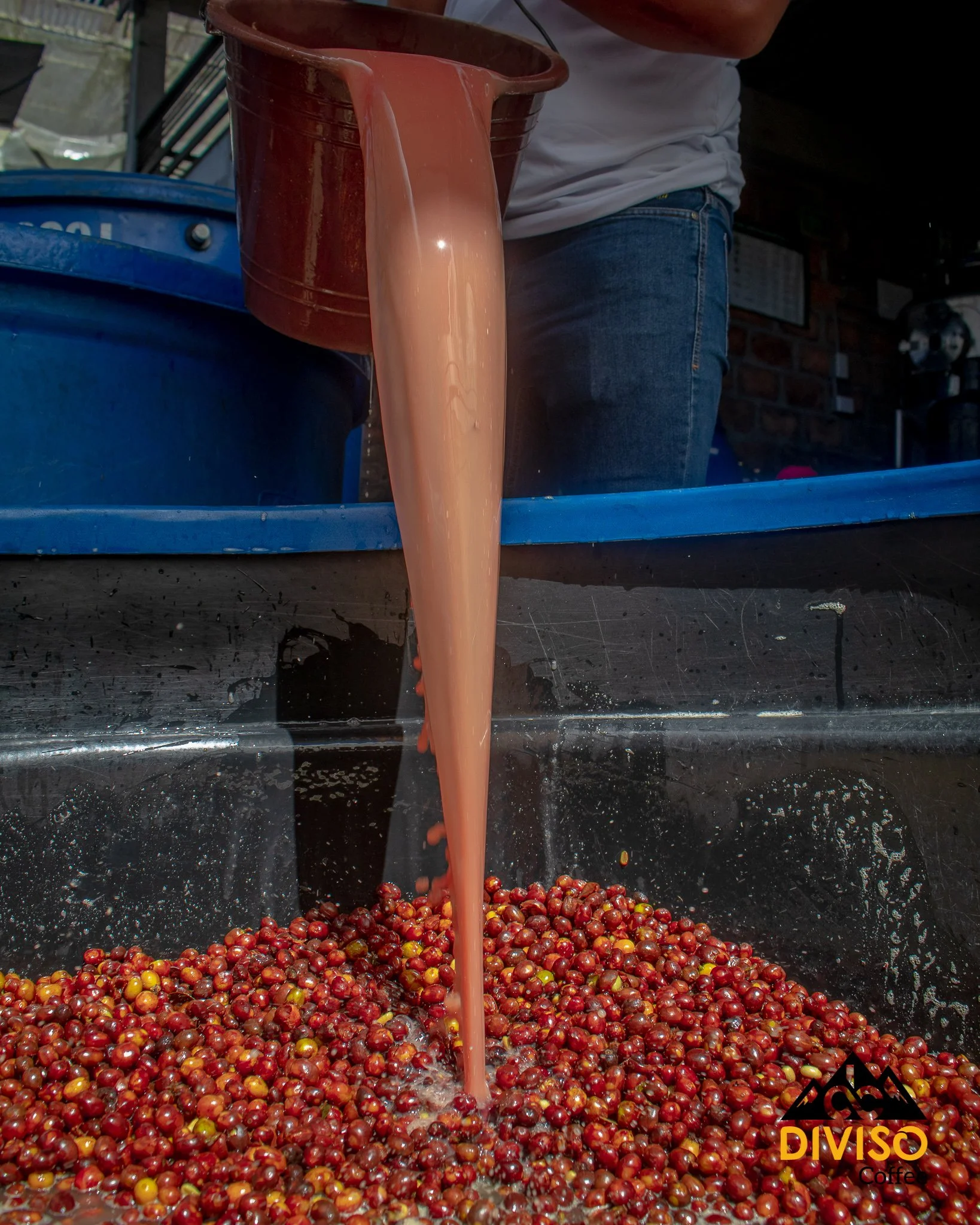DF Mossto WASHED Caturra Estate
DOUBLE ANAEROBIC WASHED ESTATE
Producer: Nestor Lasso & Adrian Lasso
Farm: Finca El Diviso
Location: 1°48'07"N 76°11'51"W
Region: Bruselas, Pitalito - Huila
Altitude: 1,820 MSAL
Variety: Caturra
Process: Double Anaerobic Mossto Washed (Started as Anaerobic Mossto Natural & Finished as Washed)
Notes:
Nestor and Adrian are two young people who represent the new generation of coffee producers in Colombia. They are risky, innovative, and they are in an endless pursuit to develop thought provoking flavor profiles that are truly one of a kind. Today, at 26 and 27, the two brothers have teamed up to run the family farm Finca El Diviso. Nestor’s coffees as of recent have developed a cult following among the hardest of hardcore connoisseurs and competitors in the industry. Nestor’s coffees have gained global acclaim by leaving their mark on the world stage which began in 2022 when his anaerobic natural Sidra was used to win the World Barista Championship. Each year forward Nestors coffees have been a regular fixture in the completion circuit as a consistent championship finalist.
Néstor at the ripe age of 27 years old, is in charge of Finca El Diviso. Once finishing high school he decided to start working directly alongside his father on the farm. He had two uncompromising rules if permanently pursuing a life in coffee: 1. he would not be willing to compromise on quality and 2. to do things in a radically different way than what was traditionally accepted in Colombia. He realized that in order to create better opportunities in coffee, he could not continue down the same old path of coffee farming and continue doing the things the old way. He had to pave a new path, so he convinced his father to plant other varieties and to start producing high-quality coffees since he saw the great potential in the specialty market. In Colombia there is a program that Nestor and his brother Adrian had attended funded by the Colombian government and today this program is recognized as one of the most renowned coffee growing institutions in Latin America, called SENA. Some of the most valuable lessons and knowledge was gained at SENA, by Nestor and Andrian. All the fundamental aspects and basics of coffee cultivation to the intricacies and science behind coffee processing were absorbed while attending the institute. In 2016, Nestor earned his technical gegree in Specialty Coffee Processing from SENA.
CATURRA VARIETY
Caturra is a natural mutation of the Bourbon variety. It was discovered on a plantation in the state of Minas Gerais in Brazil sometime between 1915 and 1918. Caturra has a single-gene mutation that causes the plant to grow smaller (called Dwarf/Compactism). Its name derives from the Guarani word meaning "small." It is also called "Nanico." After Caturra’s discovery, selections were made by the Instituto Agronomico (IAC) of Sao Paulo State in Campinas, Brazil, starting in 1937. Breeders were interested in Caturra’s small size, which allows plants to be placed closer together, and its closely spaced secondary branches, which enable it to produce more fruit in the same space. The selection process for Caturra was called mass selection, meaning that a group of individuals is selected based on their superior performance, seed from these plants is bulked to form a new generation, and then the process is repeated. The variety was never officially released in Brazil, but has become common in Central America. It was introduced in Guatemala in the 1940s, but widespread commercial adoption didn’t happen for another three decades. From Guatemala, it was introduced to Costa Rica, Honduras, and Panama. For decades, it was one of the most economically important coffees in Central America, to the extent that it was often used (and sometimes still is) as a “benchmark” against which new cultivars are tested. In Colombia, Caturra was thought to represent nearly half of the country’s production until a government-sponsored program beginning in 2008 incentivized renovation of over three billion coffee trees with the leaf-rust-resistant Castillo variety (which has Caturra parentage). Caturra led in part to the intensification of coffee cultivation through higher-density planting, often in full sun, that took place in the region in the second half of the 20th century. Caturra is also known for being one of the parents of the so-called “Catimor” family of cultivars. Various lines of the coffee-leaf-rust-resistant Timor Hybrid were crossed with Caturra to produce a Dwarf/Compact plant with rust resistance. Examples of Catimor varieties include: Costa Rica 95, Catisic, Lempira, and IHCAFE 90.For more information on the history of the Catimor group, see T8667.
Technical Information - Processing
This is a unique process when it comes to hybrid washed coffees or maybe better identified as a double anaerobic washed coffee. Basically the post harvest fermentation is started off as a double anaerobic natural and finished as a washed coffee. The process begins with a collection of ripe Caturra cherries. The cherries collected comprise of 70% ripe cherries and 30% pink with an average of 23 Brix degrees.
Initial fermentation, the cherries are collected for oxidation for 48 hours at an average room temperature of 25°C. The next step, the cherries undergo an anaerobic fermentation in sealed fermentation barrels for 20 hours at an average temperature of 16 - 18°C. Following this phase, the coffee is transferred to separate oxidation tanks to sit for 28 hours where the coffee will reach temperatures of 36°C. Following the oxidation phase, the coffee once again will undergo a second anaerobic phase but this time with added microbial mossto that was collected from the leached cherries from the previous anaerobic fermentation cycle for 18 hours and will be controlled to ferment at 16 - 20°C.
Following the second anaerobic phase, the cherry is depulped removing the bean from the fruit and soaked in tanks with mossto for 18 hours in 45°C water. Following the soaking, the coffee goes directly to canopy covered solar drying beds for 18 - 24 days. It is routinely raked and rotated to assure even exposure and drying. The final phase of drying, the coffee is placed in sealed grainpro bags for an additional 15 days. Solar dryers are an alternative form of sun drying that combines the best of both worlds when it comes to drying. It provides solar energy to dry the coffee while protecting coffees from any direct sunlight or elements brought on by wet weather, especially trying to dry coffee during La Niña. Greenhouse dryers differ from sun drying methods such as patio and raised bed in that they induce a greenhouse effect by trapping air internally and warming it by solar radiation.
REGIONAL INFORMATION
Finca El Diviso is located in the city of Bruselas in Huila. Huila, one of the most vital coffee growing regions in Colombia due to its economy, agricultural and commercial production of coffee. Huila is located in the southern portion of the country where the Central and Eastern ranges of the Andes mountains converge. Coffee being the product with the highest national production, especially of arabica that is exported to The United States, Russia, Japan and various countries around Europe. Huila’s coffee farms are predominately smallholder owned and over the past ten years have made consorted efforts to produce specialty coffee that reveals the full character of the region’s terroir. Selective manual harvesting, attentive processing, and careful post-harvest sorting all contribute to increasing recognition of the region.














